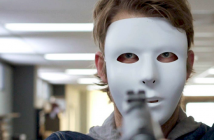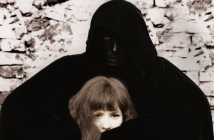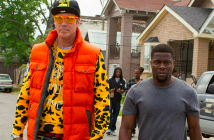
Editor’s Notes: The following review is part of our coverage for TIFF’s Dreaming in Technicolor. For more information on this TIFF film series visit http://tiff.net and follow TIFF on Twitter at @TIFF_NET.
While not the most lavish of Hollywood’s adventures in Technicolor, no film has come to represent the technology better than The Wizard of Oz. A work of dreamy fantasy, its extended opening, in sepia-tinted black and white, gives way to the spectacle of Technicolor as Dorothy exits her tornado-transported farmhouse into Munchkinland, making the very colour process appear as simple as just opening a door – like flicking a Technicolor light switch, or 75 years later clicking a mouse in PhotoShop. But nothing in The Wizard of Oz, not its childish-seeming story nor its production, is as easy it looks.
“For nearly forty years this story has given faithful service to the Young in Heart; and Time has been powerless to put its kindly philosophy out of fashion.” – thus reads an edict that follows the film’s opening credits. It’s the sort of text that might introduce a more classical work, Biblical maybe, or Homer? Robin Hood? Yet despite L. Frank Baum’s story’s age, only 39 when this film was released in 1939, it is presented here as a work of American mythology; and so successfully so that it became the cornerstone of Hollywood fantasy, nearly 40 years before Star Wars.
While not the most lavish of Hollywood’s adventures in Technicolor, no film has come to represent the technology better than The Wizard of Oz.
The story you know; Dorothy, a young Kansas girl living with her kind but no-nonsense aunt and uncle, runs away from home when she believes her beloved dog Toto is to be put down. Caught in a tornado, she is either knocked unconscious and dreams of the fantastical world of Oz, or, if you want to believe it so, is literally transported there by the tornado – the film lets you make that call. In Oz she learns important lessons, most famously that there is no place like home, but also that intelligence, compassion, and courage - all of which she shows herself to be lacking in the Kansas prologue – are the most important traits that anyone can have.

Oz itself is a delightfully silly place. The miniscule Munchkins, dwarf actors with chipmunked voices and storybook makeup and costumes, are the first inhabitants Dorothy encounters. Hailing her as a saviour for inadvertently crushing an evil witch with her house, the Munchkins parade her around town, introducing her to various Munchkin dignitaries and local unions. It’s all filler, and yet more so than the Technicolor, tornadoes or magic slippers, the infeasibility of this society is what really sells you that you’re no longer in Kansas.
Further adventures await. Dorothy meets two more witches, passive-aggressive wondersnark Glinda (Billie Burke), and the deliciously diabolical Wicked Witch of the West, played by Margaret Hamilton, who also cackled and sneered as the Kansas woman who sought poor Toto’s extermination. And then of course there’s the Scarecrow (Ray Bolger: dopey, loving, uncontrollably bendy), the Tin Man (Jack Haley: hyper-sensitive, eager, rattly), and the Cowardly Lion (Bert Lahr: über-camp, surprisingly New Yorkish, shamelessly scene-stealing). The degree of pantomime involved should make it pure farce, but the ridiculous costumes, astonishing sets and matte paintings, and devoted performances catapult it in the opposite direction towards cinematic immortality.
Throughout, the filmmakers’ superb world-building never fails to dazzle, while the movie’s themes, laid out in black and white in Kansas, carry through to the very end.
As Dorothy, Judy Garland, barely 16 at the time of filming, defines the image of the American sweetheart, wide-eyed and optimistic while grumpily aware of the daily injustices her generation must face. Garland comes off as constantly astonished in Oz without ever appearing simple, adapting to the world’s anti-logic and regularly outsmarting it. From the moment she sings the first words of ‘Over the Rainbow’ (the only fantastical thing to happen in all the Kansas scenes) a star is most assuredly born.
Oh, did I not mention it’s a musical? Well you knew that anyway. Eternal classics abound; ‘Ding-Dong! The Witch Is Dead’, ‘We’re Off to See the Wizard’, and the triptych of ‘If I Only Had…’s. Even the Winkie Guards’ marching chant has become iconic in its own way. But much of the music is actually quite forgettable, such as the various songs that introduce all the Munchkins, the Lion’s ‘If I Were King of the Forest’, and the already egregiously dated by 1939 choral piece that heralds our heroes’ escape from the enchanted poppy field. On the plus side, even ordinary songs like ‘The Merry Old Land of Oz’ have some great lyrics and delighting rhymes, although none of these can compare to Bert Lahr’s triumphant line in ‘If I Only the Nerve’, when he declares: “But I could show my prowess, Be a lion, not a mou-ouse.’
Actually for adults revisiting it, it’s easy to forget how damn funny the movie is. From the subtle touches of Dorothy constantly having to prop up the sagging Scarecrow, to the very in-your-face vaudeville of the Cowardly Lion leaping through a stained-glass window in terror, there’s a litany of laughs to be caught. Many come from the various roles played by Frank Morgan, most famously his superb delivery of the infamous “man behind the curtain” line. But even in the Kansas scenes as shyster psychic Professor Marvel he kills it, using his powers of the mind to deduce that Dorothy’s Aunt Em is named Emily.
Throughout, the filmmakers’ superb world-building never fails to dazzle, while the movie’s themes, laid out in black and white in Kansas, carry through to the very end. The farmhands who will become Dorothy’s comrades-in-arms in her dreams, each bring up the character trait their role represents long before putting on the fantastical costume; so Ray Bolger’s Hunk tells Dorothy off for not thinking through her actions, and later becomes the brainless Scarecrow. When the heroes plot to rescue Dorothy from the Wicked Witch’s castle, long before the Wizard gives them brains, a heart, or courage, it’s the Scarecrow who thinks up a plan of attack, the Tin Man who weeps with worry for Dorothy, and the Lion who first bounds into action. That’s about as tight as storytelling can get.
Oh, and as for Technicolor, The Wizard of Oz may be famous for that brazen sepia-to-colour transition, but really Technicolor is employed so subtly in this film. Munchkinland, for example, is all dull colours, eggshell, straw, and browns. But then the Munchkins themselves emerge, garbed in luscious purples, budgie yellows, and of course emerald greens; the colours leap off the screen. Similarly, our four heroes are all dressed in pastels or dull monotones, so that the magic appears in the details around them. When they arrive at Oz proper, they ride in a carriage pulled by the “horse of many colours”, whose hair is painted a new and magical Technicolor shade every time the film cuts back to it. It’s unsophisticated, but it’s spectacular. And that’s what really makes a timeless classic.
A triumph of Hollywood mythmaking, using all the tricks in the book and adding a few extra pages itself. Charming, funny, tirelessly magical, and far smarter than you remember.



